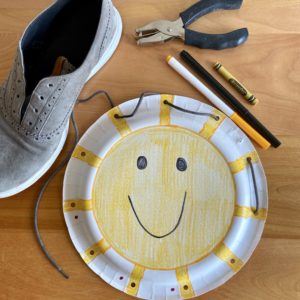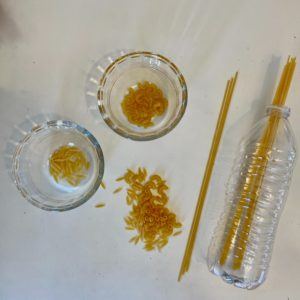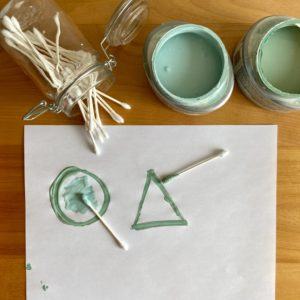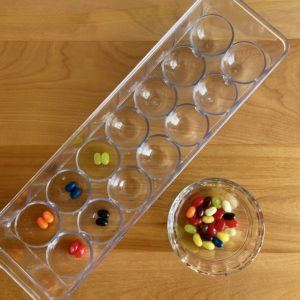Fun ideas for adapting at-home materials into fine motor activities
There are many ways to adapt materials found in the home to address children’s needs. Feel free to substitute any of the supplies below with something similar.
Homemade Lacing Card – lacing cards promote skills including bilateral integration, visual motor integration, and grasp. These skills support daily activities such as handwriting, cutting, and dressing. To make one at home you will need: a marker, a single hole punch, a shoe-lace, and a paper plate.

- You are going to punch the holes in the “rim” of the plate. It is easier to work from the back side of the plate. Have your child help you mark where the holes will go, 1-3 inches apart.
- Using your hole punch, punch through each marked dot. If your child is able, have them help you place and squeeze the hole punch.
- Tie a knot in one end of your shoe lace and thread the end without a knot through the first hole to begin. Your child may need demonstration or some assistance but with enough practice they will be doing it independently!
Pasta Play – small objects can be used in a variety of ways to promote executive functioning, visual perceptual skills, grasp, and midline crossing. These skills support daily activities such as puzzles, self-feeding, and handwriting. For these activities, I used a variety of dried pasta shapes.

- Sorting: have your child sort the small pasta into a bowl or container. As your child picks up each piece, encourage use of the thumb and pointer finger to promote a mature pincer grasp.
- Pattern-making: have your child create patterns with the pasta, by reaching across their body to pick up and place each piece.
- Fill the bottle: have your child place dried spaghetti noodles into the opening of a water bottle – the smaller the opening, the harder the activity. You can either stabilize the bottle for your child or have them use one hand to stabilize the bottle while placing pasta with the other.
Painting – painting and drawing help promote visual motor integration, executive functioning, and grasp. If you don’t have a paint brush at home, use a Q-tip instead! The short and thin nature of the Q-tip will naturally encourage your child to use a more mature grasp. With a Q-tip and paint, have your child draw pictures, trace shapes, or write letters.

Egg Carton Sorting – occupational therapists use many activities to help kids develop a pincer grasp that is strong, effective, and efficient. A strong pincer grasp supports dressing, self-feeding, and helps prepare for handwriting. A great way to promote this grasp with things you have in the house requires an egg carton and objects such as jelly beans. Have your child reach into each “pocket” of the carton to retrieve the objects or sort by color or size.

For more information, visit http://www.abcpediatrictherapy.com
Developmental Checklist
Is your child meeting their developmental milestones?
 Skip to content
Skip to content